tires MAZDA MODEL 3 HATCHBACK 2005 (in English) Owner's Guide
[x] Cancel search | Manufacturer: MAZDA, Model Year: 2005, Model line: MODEL 3 HATCHBACK, Model: MAZDA MODEL 3 HATCHBACK 2005Pages: 322, PDF Size: 4.7 MB
Page 239 of 322
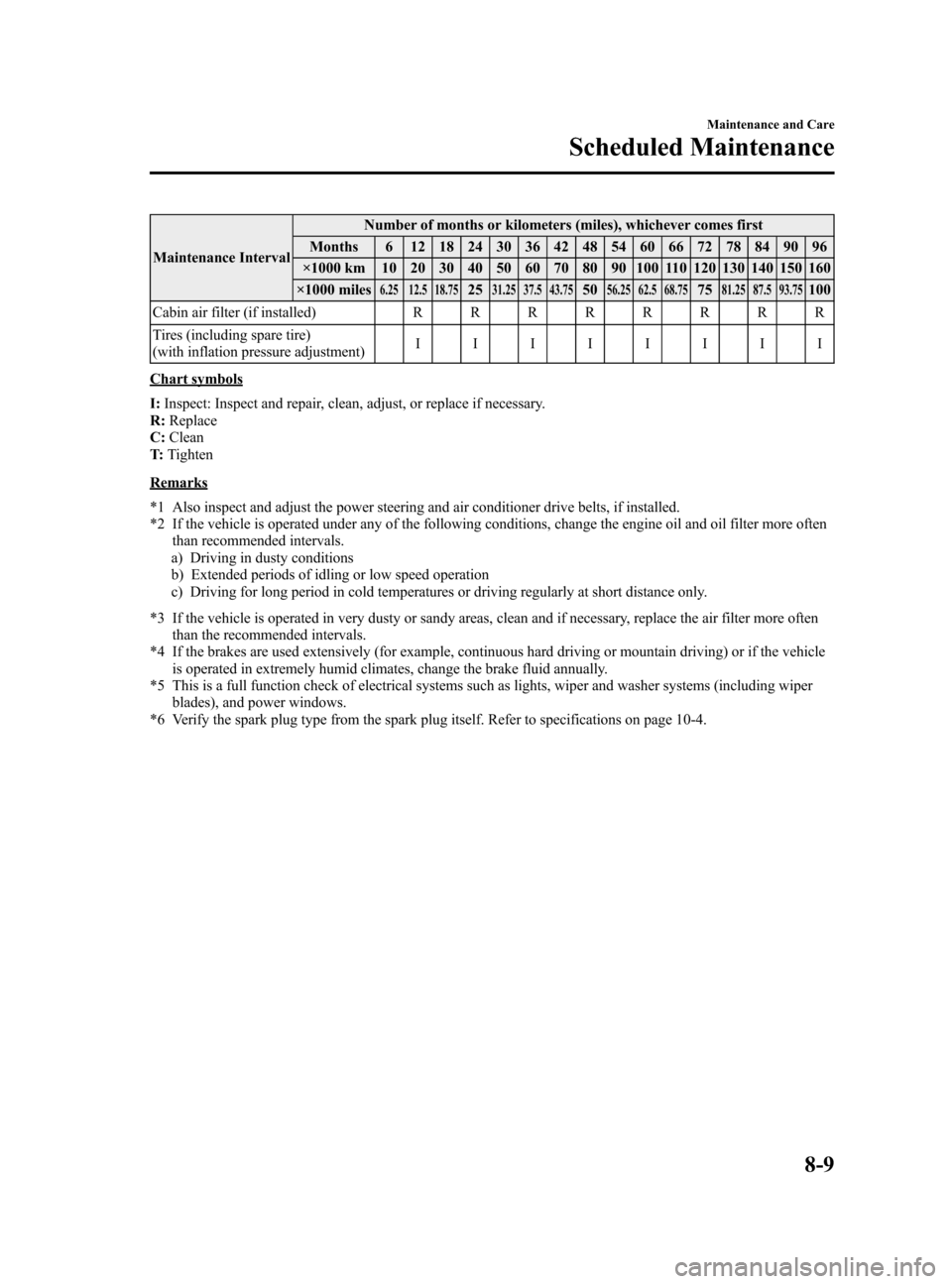
Black plate (239,1)
Maintenance IntervalNumber of months or kilometers (miles), whichever comes first
Months 6 12 18 24 30 36 42 48 54 60 66 72 78 84 90 96
×1000 km 10 20 30 40 50 60 70 80 90 100 110 120 130 140 150 160
×1000 miles
6.25 12.5 18.752531.25 37.5 43.755056.25 62.5 68.757581.25 87.5 93.75100
Cabin air filter (if installed) R R R R R R R R
Tires (including spare tire)
(with inflation pressure adjustment)IIIIIIII
Chart symbols
I:Inspect: Inspect and repair, clean, adjust, or replace if necessary.
R:Replace
C:Clean
T:Tighten
Remarks
*1 Also inspect and adjust the power steering and air conditioner drive belts, if installed.
*2 If the vehicle is operated under any of the following conditions, change the engine oil and oil filter more often
than recommended intervals.
a) Driving in dusty conditions
b) Extended periods of idling or low speed operation
c) Driving for long period in cold temperatures or driving regularly at short distance only.
*3 If the vehicle is operated in very dusty or sandy areas, clean and if necessary, replace the air filter more often
than the recommended intervals.
*4 If the brakes are used extensively (for example, continuous hard driving or mountain driving) or if the vehicle
is operated in extremely humid climates, change the brake fluid annually.
*5 This is a full function check of electrical systems such as lights, wiper and washer systems (including wiper
blades), and power windows.
*6 Verify the spark plug type from the spark plug itself. Refer to specifications on page 10-4.
Maintenance and Care
Scheduled Maintenance
8-9
Mazda3_8T97-EC-04J_Edition1 Page239
Saturday, September 25 2004 2:16 PM
Form No.8T97-EC-04J
Page 260 of 322
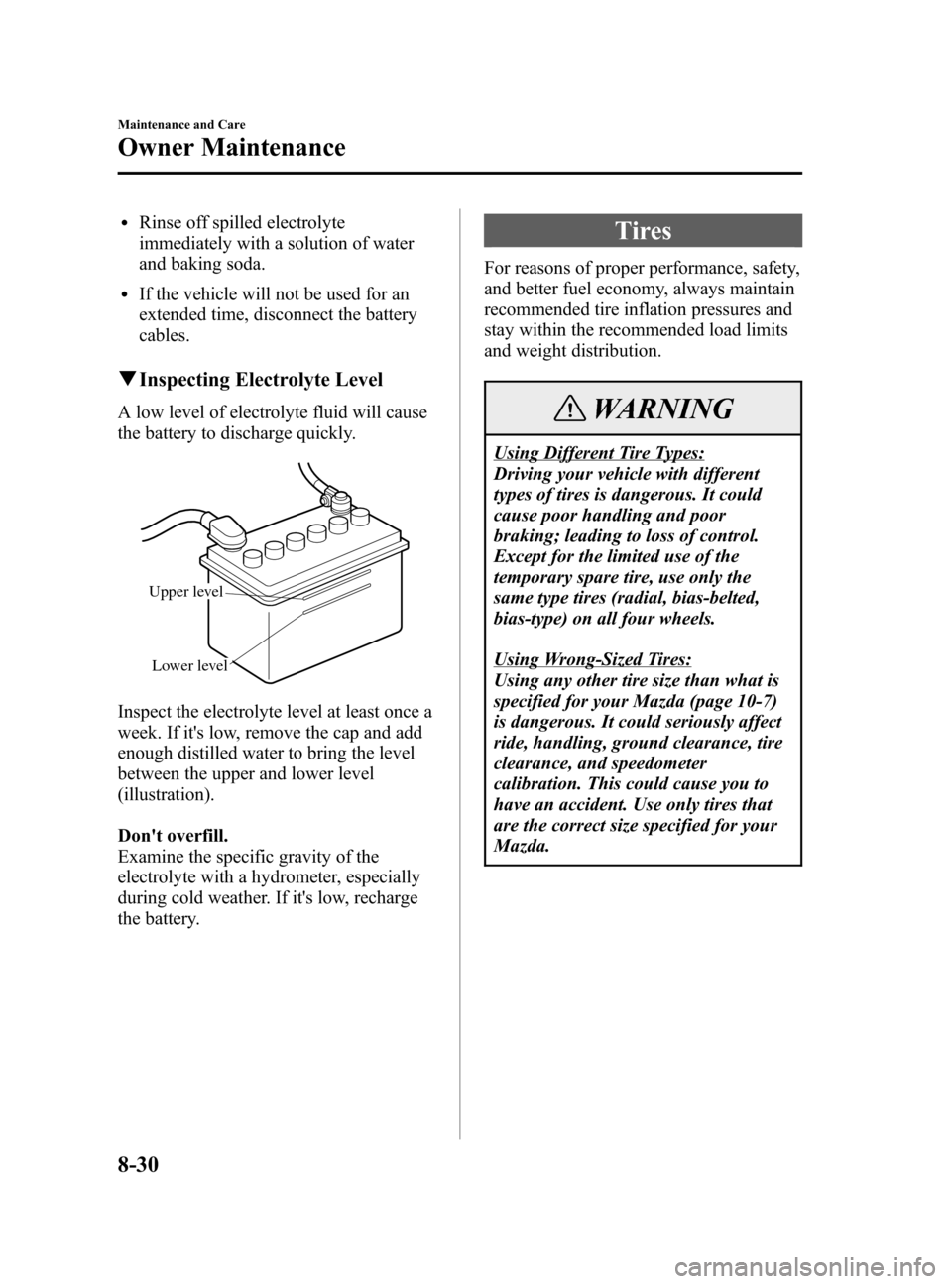
Black plate (260,1)
lRinse off spilled electrolyte
immediately with a solution of water
and baking soda.
lIf the vehicle will not be used for an
extended time, disconnect the battery
cables.
qInspecting Electrolyte Level
A low level of electrolyte fluid will cause
the battery to discharge quickly.
Upper level
Lower level
Inspect the electrolyte level at least once a
week. If it's low, remove the cap and add
enough distilled water to bring the level
between the upper and lower level
(illustration).
Don't overfill.
Examine the specific gravity of the
electrolyte with a hydrometer, especially
during cold weather. If it's low, recharge
the battery.
Tires
For reasons of proper performance, safety,
and better fuel economy, always maintain
recommended tire inflation pressures and
stay within the recommended load limits
and weight distribution.
WARNING
Using Different Tire Types:
Driving your vehicle with different
types of tires is dangerous. It could
cause poor handling and poor
braking; leading to loss of control.
Except for the limited use of the
temporary spare tire, use only the
same type tires (radial, bias-belted,
bias-type) on all four wheels.
Using Wrong-Sized Tires:
Using any other tire size than what is
specified for your Mazda (page 10-7)
is dangerous. It could seriously affect
ride, handling, ground clearance, tire
clearance, and speedometer
calibration. This could cause you to
have an accident. Use only tires that
are the correct size specified for your
Mazda.
8-30
Maintenance and Care
Owner Maintenance
Mazda3_8T97-EC-04J_Edition1 Page260
Saturday, September 25 2004 2:16 PM
Form No.8T97-EC-04J
Page 261 of 322

Black plate (261,1)
qTire Inflation Pressure
WARNING
Incorrect Tire Inflation:
Overinflation or underinflation of tires
is dangerous. Adverse handling or
unexpected tire failure could result in
a serious accident. Always inflate the
tires to the correct pressure (page
10-7).
The Tire Pressure Monitoring System
í
does not alleviate the need to check the
tire condition every day, including
whether the tires all look inflated properly.
Inspect all tire pressure monthly
(including the spare) when the tires are
cold. Maintain recommended pressures
for the best ride, top handling, and
minimum tire wear.
Refer to the specification charts (page
10-7).
NOTE
lAlways check tire pressure when
tires are cold.
lWarm tires normally exceed
recommended pressures. Don't
release air from warm tires to adjust
the pressure.
lUnderinflation can cause reduced
fuel economy and poor sealing of the
tire bead, which will deform the
wheel and cause separation of tire
from rim.
lOverinflation can produce a harsh
ride and a greater possibility of
damage from road hazards.
Keep your tire pressure at the correct
levels. If one frequently needs
inflating, have it inspected.
qTire Rotation
To equalize tread wear, rotate the tires
every 12,000 km (7,500 miles)/8,000 km*
(5,000 miles) or sooner if irregular wear
develops. During rotation, inspect them
for correct balance.
* Unique driving conditions for U.S.A.,
Canada and Puerto Rico
Do not include (TEMPORARY USE ONLY)
spare tire in rotation.Forward
Maintenance and Care
Owner Maintenance
8-31íSome models. Mazda3_8T97-EC-04J_Edition1 Page261
Saturday, September 25 2004 2:16 PM
Form No.8T97-EC-04J
Page 262 of 322

Black plate (262,1)
Also, inspect them for uneven wear and
damage. Abnormal wear is usually caused
by one or a combination of the following:
lIncorrect tire pressure
lImproper wheel alignment
lOut-of-balance wheel
lSevere braking
After rotation, inflate all tire pressures to
specification (page 10-7) and inspect the
lug nuts for tightness.
CAUTION
Rotate unidirectional tires and radial
tires that have an asymmetrical tread
pattern or studs only from front to rear,
not from side to side. Tire performance
will be weakened if rotated from side to
side.
qReplacing a Tire
WARNING
Worn Tires:
Driving with worn tires is dangerous.
Reduced braking, steering, and
traction could result in an accident.
Always use tires that are in good
condition.
CAUTION
(With Tire Pressure Monitoring
System)
When replacing/repairing the tires or
wheels or both, have the work done by
an Authorized Mazda Dealer, or the tire
pressure sensors may be damaged.
NOTE
(With Tire Pressure Monitoring
System)
lWhen tires with steel wire
reinforcement in the sidewalls are
used, the system may not function
correctly even with a genuine wheel.
Refer to System Error Activation on
page 5-23.
lBe sure to install the tire pressure
sensors whenever tires or wheels are
replaced. Refer to Tires and Wheels
on page 5-23.
If a tire wears evenly, a wear indicator
will appear as a solid band across the
tread.
Replace the tire when this happens.
New treadTread wear indicator
Worn tread
8-32
Maintenance and Care
Owner Maintenance
Mazda3_8T97-EC-04J_Edition1 Page262
Saturday, September 25 2004 2:16 PM
Form No.8T97-EC-04J
Page 263 of 322
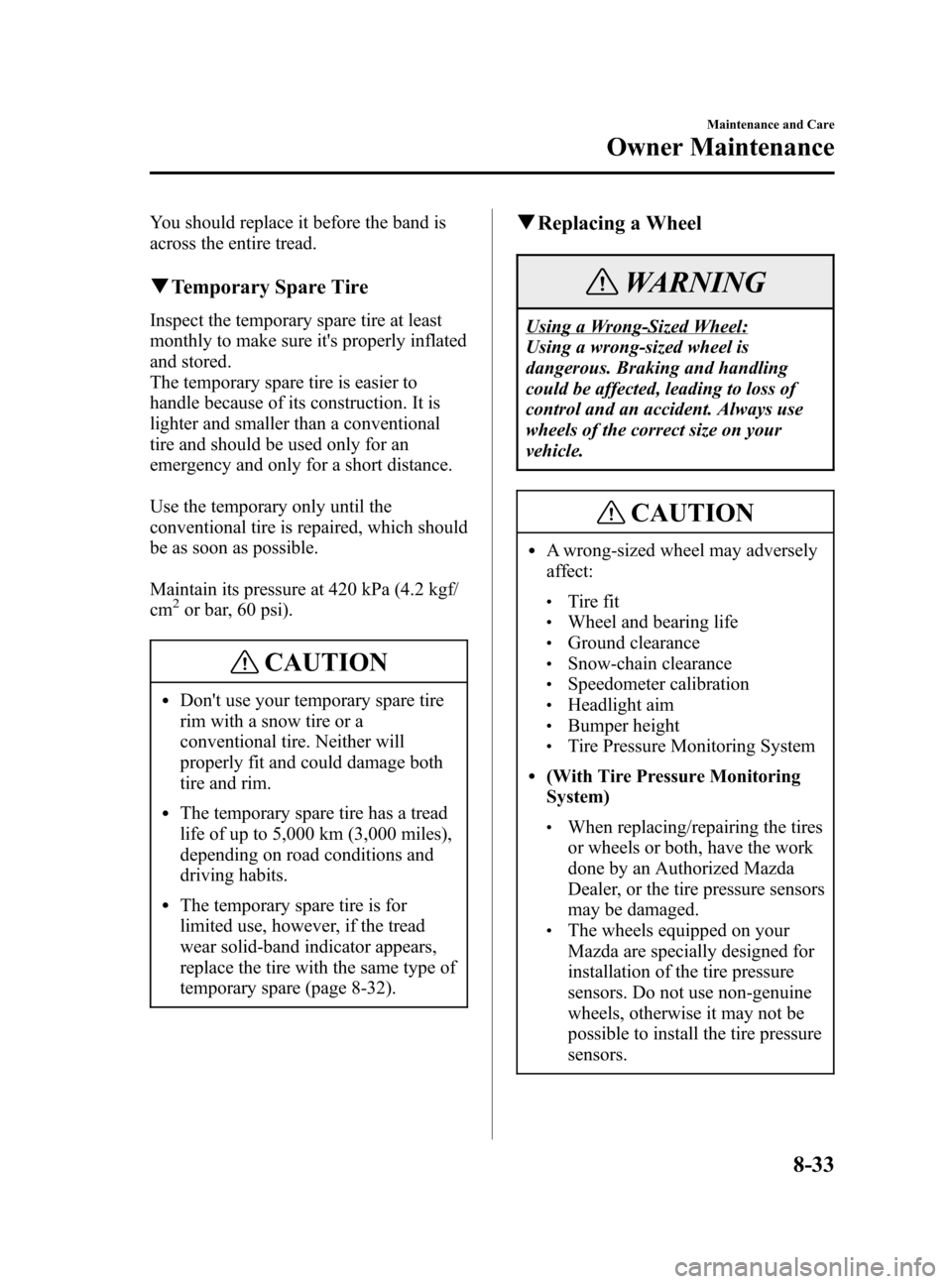
Black plate (263,1)
You should replace it before the band is
across the entire tread.
qTemporary Spare Tire
Inspect the temporary spare tire at least
monthly to make sure it's properly inflated
and stored.
The temporary spare tire is easier to
handle because of its construction. It is
lighter and smaller than a conventional
tire and should be used only for an
emergency and only for a short distance.
Use the temporary only until the
conventional tire is repaired, which should
be as soon as possible.
Maintain its pressure at 420 kPa (4.2 kgf/
cm
2or bar, 60 psi).
CAUTION
lDon't use your temporary spare tire
rim with a snow tire or a
conventional tire. Neither will
properly fit and could damage both
tire and rim.
lThe temporary spare tire has a tread
life of up to 5,000 km (3,000 miles),
depending on road conditions and
driving habits.
lThe temporary spare tire is for
limited use, however, if the tread
wear solid-band indicator appears,
replace the tire with the same type of
temporary spare (page 8-32).
qReplacing a Wheel
WARNING
Using a Wrong-Sized Wheel:
Using a wrong-sized wheel is
dangerous. Braking and handling
could be affected, leading to loss of
control and an accident. Always use
wheels of the correct size on your
vehicle.
CAUTION
lA wrong-sized wheel may adversely
affect:
lTire fitlWheel and bearing lifelGround clearancelSnow-chain clearancelSpeedometer calibrationlHeadlight aimlBumper heightlTire Pressure Monitoring System
l(With Tire Pressure Monitoring
System)
lWhen replacing/repairing the tires
or wheels or both, have the work
done by an Authorized Mazda
Dealer, or the tire pressure sensors
may be damaged.
lThe wheels equipped on your
Mazda are specially designed for
installation of the tire pressure
sensors. Do not use non-genuine
wheels, otherwise it may not be
possible to install the tire pressure
sensors.
Maintenance and Care
Owner Maintenance
8-33
Mazda3_8T97-EC-04J_Edition1 Page263
Saturday, September 25 2004 2:16 PM
Form No.8T97-EC-04J
Page 264 of 322

Black plate (264,1)
NOTE
Be sure to install the tire pressure
sensors whenever tires or wheels are
replaced. Refer to Tires and Wheels on
page 5-23.
When replacing a wheel, make sure the
new one is the same as the original factory
wheel in diameter, rim width, and offset.
Proper tire balancing provides the best
riding comfort and helps reduce tread
wear. Out-of-balance tires can cause
vibration and uneven wear, such as
cupping and flat spots.
8-34
Maintenance and Care
Owner Maintenance
Mazda3_8T97-EC-04J_Edition1 Page264
Saturday, September 25 2004 2:16 PM
Form No.8T97-EC-04J
Page 283 of 322

Black plate (283,1)
qWater Marks
Occurrence
Rain, fog, dew, and even tap water can
contain harmful minerals such as salt and
lime. If moisture containing these
minerals settles on the vehicle and
evaporates, the minerals will concentrate
and harden to form white rings. The rings
can damage your vehicle's finish.
Prevention
It is necessary to wash and wax your
vehicle to preserve its finish according to
the instructions in this section. These
steps should be taken immediately after
you find water marks on your vehicle's
finish.
qPaint Chipping
Occurrence
Paint chipping occurs when gravel thrown
in the air by another vehicle's tires hits
your vehicle.
How to avoid paint chipping
Keeping a safe distance between you and
the vehicle ahead reduces the chances of
having your paint chipped by flying
gravel.
NOTE
lThe paint chipping zone varies with
the speed of the vehicle. For
example, when traveling at 90 km/h
(56 mph), the paint chipping zone is
50 m (164 ft).
lIn low temperatures a vehicle's finish
hardens. This increases the chance of
paint chipping.
lChipped paint can lead to rust
forming on your Mazda. Before this
happens, repair the damage by using
Mazda touch-up paint according to
the instructions in this section.
Failure to repair the affected area
could lead to serious rusting and
expensive repairs.
Maintenance and Care
Appearance Care
8-53
Mazda3_8T97-EC-04J_Edition1 Page283
Saturday, September 25 2004 2:17 PM
Form No.8T97-EC-04J
Page 304 of 322
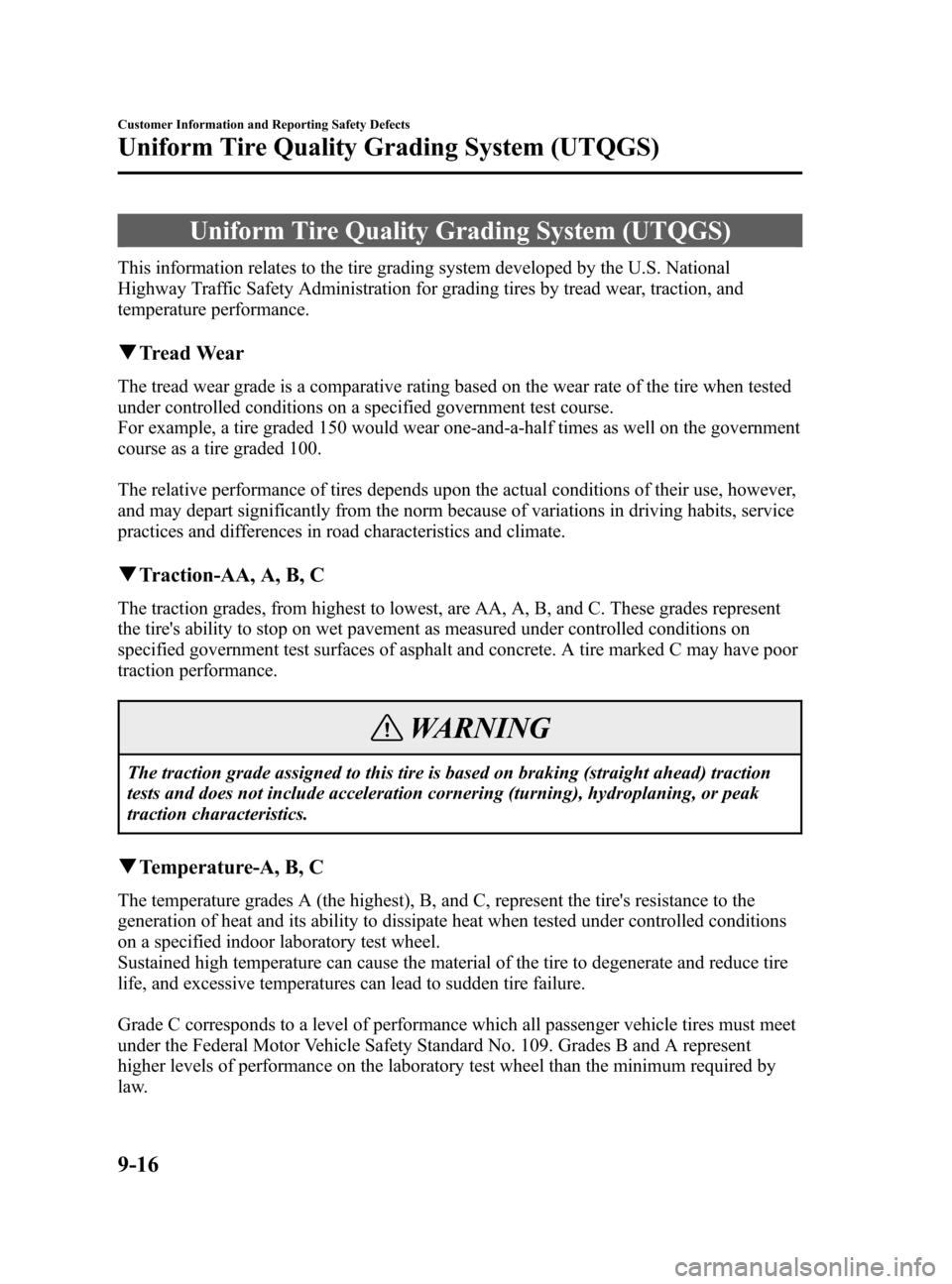
Black plate (304,1)
Uniform Tire Quality Grading System (UTQGS)
This information relates to the tire grading system developed by the U.S. National
Highway Traffic Safety Administration for grading tires by tread wear, traction, and
temperature performance.
qTread Wear
The tread wear grade is a comparative rating based on the wear rate of the tire when tested
under controlled conditions on a specified government test course.
For example, a tire graded 150 would wear one-and-a-half times as well on the government
course as a tire graded 100.
The relative performance of tires depends upon the actual conditions of their use, however,
and may depart significantly from the norm because of variations in driving habits, service
practices and differences in road characteristics and climate.
qTraction-AA, A, B, C
The traction grades, from highest to lowest, are AA, A, B, and C. These grades represent
the tire's ability to stop on wet pavement as measured under controlled conditions on
specified government test surfaces of asphalt and concrete. A tire marked C may have poor
traction performance.
WARNING
The traction grade assigned to this tire is based on braking (straight ahead) traction
tests and does not include acceleration cornering (turning), hydroplaning, or peak
traction characteristics.
qTemperature-A, B, C
The temperature grades A (the highest), B, and C, represent the tire's resistance to the
generation of heat and its ability to dissipate heat when tested under controlled conditions
on a specified indoor laboratory test wheel.
Sustained high temperature can cause the material of the tire to degenerate and reduce tire
life, and excessive temperatures can lead to sudden tire failure.
Grade C corresponds to a level of performance which all passenger vehicle tires must meet
under the Federal Motor Vehicle Safety Standard No. 109. Grades B and A represent
higher levels of performance on the laboratory test wheel than the minimum required by
law.
9-16
Customer Information and Reporting Safety Defects
Uniform Tire Quality Grading System (UTQGS)
Mazda3_8T97-EC-04J_Edition1 Page304
Saturday, September 25 2004 2:17 PM
Form No.8T97-EC-04J
Page 305 of 322

Black plate (305,1)
WARNING
The temperature grade for this tire is established for a tire that is properly inflated and
not overloaded. Excessive speed, underinflation, or excessive loading, either
separately or in combination, can cause heat buildup and possible tire failure.
These grades will be added to the sidewalls of passenger vehicle tires over the next several
years according to a schedule established by the NHTSA and the tire manufacturers.
The grade of tires available as standard or optional equipment on Mazda vehicles may vary
with respect to grade.
ALL PASSENGER VEHICLE TIRES MUST CONFORM TO THESE GRADES AND
TO ALL OTHER FEDERAL TIRE-SAFETY REQUIREMENTS.
qUniform Tire Quality Grading
Quality grades can be found where applicable on the tire sidewall between tread shoulder
and maximum section width.
For example:
Treadwear 200 Traction AA Temperature A
TREADWEAR 200 TRACTION AA
TEMPERATURE A
UTQGS MARK (example)
Customer Information and Reporting Safety Defects
Uniform Tire Quality Grading System (UTQGS)
9-17
Mazda3_8T97-EC-04J_Edition1 Page305
Saturday, September 25 2004 2:17 PM
Form No.8T97-EC-04J
Page 315 of 322
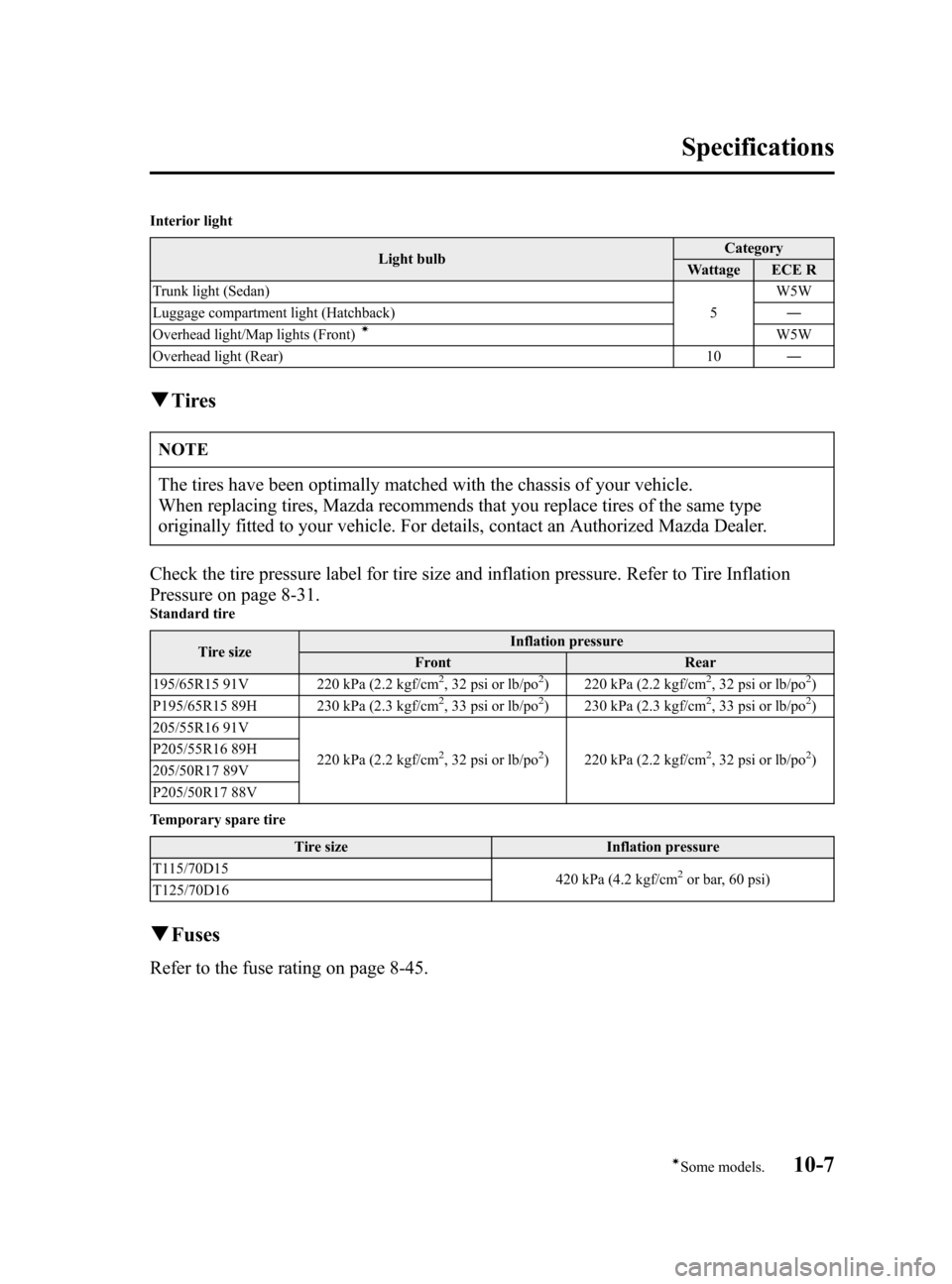
Black plate (315,1)
Interior light
Light bulbCategory
Wattage ECE R
Trunk light (Sedan)
5W5W
Luggage compartment light (Hatchback)―
Overhead light/Map lights (Front)
íW5W
Overhead light (Rear) 10―
qTires
NOTE
The tires have been optimally matched with the chassis of your vehicle.
When replacing tires, Mazda recommends that you replace tires of the same type
originally fitted to your vehicle. For details, contact an Authorized Mazda Dealer.
Check the tire pressure label for tire size and inflation pressure. Refer to Tire Inflation
Pressure on page 8-31.
Standard tire
Tire sizeInflation pressure
Front Rear
195/65R15 91V 220 kPa (2.2 kgf/cm
2, 32 psi or lb/po2) 220 kPa (2.2 kgf/cm2, 32 psi or lb/po2)
P195/65R15 89H 230 kPa (2.3 kgf/cm2, 33 psi or lb/po2) 230 kPa (2.3 kgf/cm2, 33 psi or lb/po2)
205/55R16 91V
220 kPa (2.2 kgf/cm
2, 32 psi or lb/po2) 220 kPa (2.2 kgf/cm2, 32 psi or lb/po2) P205/55R16 89H
205/50R17 89V
P205/50R17 88V
Temporary spare tire
Tire size Inflation pressure
T115/70D15
420 kPa (4.2 kgf/cm
2or bar, 60 psi)
T125/70D16
qFuses
Refer to the fuse rating on page 8-45.
Specifications
10-7íSome models. Mazda3_8T97-EC-04J_Edition1 Page315
Saturday, September 25 2004 2:17 PM
Form No.8T97-EC-04J